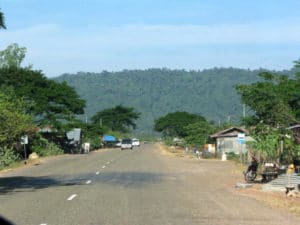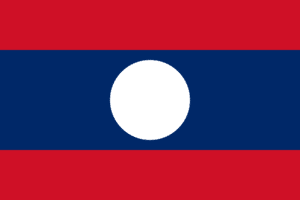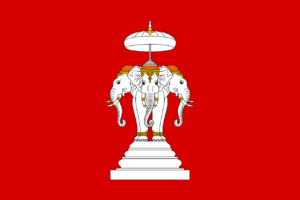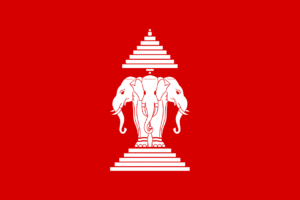The major roads connecting the major urban centers, in particular Route 13, have been significantly upgraded in recent years, but villages far from major roads can be reached only through unpaved roads that may not be accessible year-round.

Flag of Laos:
The flag of Laos consists of three horizontal stripes, with the middle stripe in blue being twice the height of the top and bottom red stripes. In the middle is a white disc, the diameter of the disc is 4⁄5 the height of the blue stripe. The national flag of Laos was first adopted in 1945 under the short-lived Lao Issara government of 1945–46, then by the Pathet Lao. It is one of the two flags of a currently communist country (the other being Cuba) that does not use any communist symbolism and the only current communist country that does not use a five-pointed star in its flag as an emblem. The current flag was adopted on December 2, 1975 when it became a socialist state.

This current flag replaced the red flag, with a triple-headed white elephant on a pedestal beneath a parasol, which had been the flag of the 19th century Kingdom of Luang Phrabang.

The flag had continued to be used when this kingdom became a French protectorate, and following its unification with the other provinces of Laos into the Kingdom of Laos, which became independent in 1953.

The flag expressed the ancient name of the country, “Land of a Million Elephants”. From 1953 onward the royal government waged war with the Pathet Lao, whose flag was blue with a white disk and red borders at the top and bottom.
From 1973 to 1975, the Pathet Lao formed part of the government coalition, before assuming power directly and prompting the abdication of the king. Their flag was adopted as the national flag. According to the original creator of the current Lao flag, Maha Sila Viravong, the white disk in the center symbolizes the unity of the Lao people (and the future reunification of the two Laotian regions of Laos and Northeastern Thailand that are divided by the Mekong River) under one nation. It is also said to represent a full moon against the Mekong River. The red stripes stand for the blood shed by the Lao people on both banks of the Mekong River (the multi-ethnic people of Laos and the Isan people of Northeastern Thailand) in their struggle for freedom and independence from the French, and the blue symbolizes the Mekong River itself, a symbol of the nation’s prosperity.
